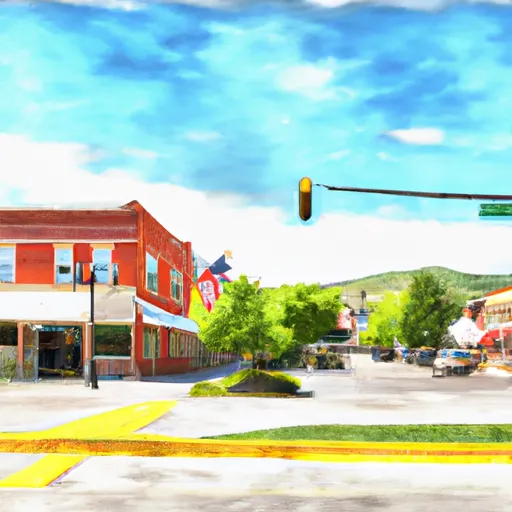-
 Snoflo Premium
Snoflo Premium
Get unlimited access to all our content
With no Ad interruptions! - Start Your Free Trial Login with existing account
Manhattan
Eden Index
Climate
7.2
•
Recreation
3.8
•
Community
•
Safeguard
4.2/10

Manhattan, Montana is a small town situated in the heart of the Gallatin Valley. The climate is classified as continental, characterized by cold winters and warm summers. Average temperatures range from 15°F (-9°C) in winter to 85°F (29°C) in summer. Precipitation is moderate, with an average annual rainfall of around 16 inches (41 cm), and snowfall is common during the winter months.
The town lies near the headwaters of the Gallatin River, which provides a significant water source for the community. The river is known for its pristine waters and offers excellent fishing opportunities, especially for trout enthusiasts. Additionally, the Gallatin Valley is dotted with numerous lakes and reservoirs, providing additional options for boating, kayaking, and paddleboarding.
Outdoor recreation opportunities in Manhattan are abundant. The surrounding area is a haven for hikers and backpackers, with nearby mountain ranges, such as the Bridger Range and the Gallatin Range, offering stunning trails and breathtaking views. The region also boasts multiple campgrounds and picnic areas, making it ideal for family outings. Wildlife watching, hunting, and birding are popular activities, with abundant opportunities to spot deer, elk, moose, and various bird species.
Overall, Manhattan, Montana offers a picturesque location with a diverse range of outdoor activities, making it a desirable destination for nature enthusiasts.
What is the Eden Index?
The Snoflo Eden Index serves as a comprehensive rating system for regions, evaluating their desirability through a holistic assessment of climate health, outdoor recreation opportunities, and natural disaster risk, acknowledging the profound impact of these factors on livability and well-being.
Climate Health Indicator (CHI): 7.2
Manhattan receives approximately
342mm of rain per year,
with humidity levels near 63%
and air temperatures averaging around
7°C.
Manhattan has a plant hardyness factor of
4, meaning
plants and agriculture in this region thrive during a short period during spring and early summer. Most
plants will die off during the colder winter months.
By considering the ideal temperature range, reliable water supplies, clean air, and stable seasonal rain or snowpacks, the Climate Health Indicator (CHI) underscores the significance of a healthy climate as the foundation for quality living.
A healthy climate is paramount for ensuring a high quality of life and livability in a region, fostering both physical well-being and environmental harmony. This can be characterized by ideal temperatures, reliable access to water supplies, clean air, and consistent seasonal rain or snowpacks.
Weather Forecast
Streamflow Conditions
Missouri Headwaters
Area Rivers
Missouri Headwaters
Snowpack Depths
Missouri Headwaters
Reservoir Storage Capacity
Missouri Headwaters
Groundwater Levels
Recreational Opportunity Index (ROI): 3.8
The Recreational Opportunity Index (ROI) recognizes the value of outdoor recreational options, such as parks, hiking trails, camping sites, and fishing spots, while acknowledging that climate plays a pivotal role in ensuring the comfort and consistency of these experiences.
Access to outdoor recreational opportunities, encompassing activities such as parks, hiking, camping, and fishing, is crucial for overall well-being, and the climate plays a pivotal role in enabling and enhancing these experiences, ensuring that individuals can engage in nature-based activities comfortably and consistently.
Camping Areas
| Campground | Campsites | Reservations | Toilets | Showers | Elevation |
|---|---|---|---|---|---|
| Spire Rock | 22 | 5,608 ft | |||
| Swan Creek | 13 | 5,831 ft | |||
| Greek Creek | 15 | 5,634 ft | |||
| Deepdale FAS | None | 3,845 ft | |||
| Yorks Islands FAS | 10 | 3,851 ft | |||
| Missouri Headwaters State Park | 25 | 4,046 ft | |||
| Moose Creek Flat | 15 | 5,716 ft | |||
| Fairweather FAS | None | 3,987 ft | |||
| Canyon Ferry Lake | None | 3,799 ft | |||
| Toston Dam | None | 4,215 ft |
Nearby Ski Areas
Catastrophe Safeguard Index (CSI):
The Catastrophe Safeguard Index (CSI) recognizes that natural disaster risk, encompassing floods, fires, hurricanes, and tornadoes, can drastically affect safety and the overall appeal of an area.
The level of natural disaster risk in a region significantly affects safety and the overall livability, with climate change amplifying these risks by potentially increasing the frequency and intensity of events like floods, fires, hurricanes, and tornadoes, thereby posing substantial challenges to community resilience and well-being.
Community Resilience Indicator (CRI):
The Community Resilience Indicator (CRI) recognizes that education, healthcare, and socioeconomics are crucial to the well-being of a region. The CRI acknowledges the profound impact of these elements on residents' overall quality of life. By evaluating educational resources, healthcare accessibility, and economic inclusivity, the index captures the essential aspects that contribute to a thriving community, fostering resident satisfaction, equity, and social cohesion.

